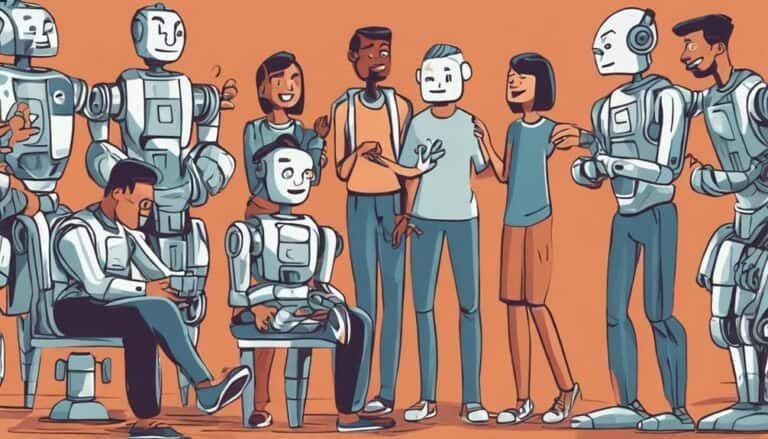Robotics for Kids: Engage with Future Tech!
Robotics for Kids is an exciting and educational field that combines technology, engineering, and programming. By engaging with robotics, children can develop important skills such as problem-solving, creativity, and critical thinking. It also opens up future opportunities in STEM-related careers. Let’s explore the world of robotics for kids and how it can shape the future.
Key Takeaways:
- Robotics for kids combines technology, engineering, and programming to develop critical skills.
- Engaging with robotics promotes problem-solving, creativity, and critical thinking.
- Robotics offers future opportunities in STEM-related careers.
- Introducing kids to robotics at a young age sparks their interest in technology and develops a strong foundation in STEM learning.
- Choosing age-appropriate robotics kits ensures children can engage and learn at their own pace.
Introducing Robotics to Kids: Getting Started
Introducing kids to robotics at a young age is an exciting way to ignite their curiosity and enthusiasm for technology. It lays the foundation for understanding the basics of robotics, including how robots are built, programmed, and operate. By getting started with age-appropriate robotics kits, children can embark on an educational journey that combines fun and learning while fostering essential STEM (Science, Technology, Engineering, and Mathematics) skills.
When introducing robotics to kids, it’s important to choose kits that are suitable for their age and skill level. Starting with easy-to-understand concepts and projects ensures that children can grasp the fundamentals and progressively build upon their knowledge. Age-appropriate robotics kits offer a structured approach that enables children to develop problem-solving abilities, logical thinking, and creativity.
Robotic kits designed for children typically come with building components, sensors, and programmable elements. These kits often provide step-by-step instructions and intuitive software interfaces, making it accessible for kids to assemble and program their robots. By engaging in hands-on activities, children gain a practical understanding of the underlying principles of robotics.
“Engaging kids with robotics at an early age opens up a world of possibilities. It nurtures their natural curiosity and fosters creativity, problem-solving, and critical thinking skills.” – Sarah Johnson, Robotics Educator
By exploring the basics of robotics, kids not only learn about technology but also develop essential 21st-century skills. They enhance their ability to collaborate, communicate, and think critically, equipping them for future success in a rapidly evolving world. Robotics for kids also lays the groundwork for potential future careers in fields such as engineering, computer science, or AI research.
The Benefits of Getting Started with Robotics
Getting started with robotics offers a myriad of benefits for children:
- Develops problem-solving skills
- Fosters creativity and innovation
- Enhances logical thinking and critical reasoning
- Promotes teamwork and collaboration
- Builds a foundation for future STEM learning
- Ignites curiosity and a love for learning
By embracing the exciting world of robotics, children gain valuable insights into technology and its potential to shape the future. It empowers them to become active creators and inventors, fueling their passion for discovery and exploration.
| Age Group | Recommended Robotics Kits |
|---|---|
| 4-7 years | Lego Education WeDo 2.0 |
| 8-11 years | Makeblock mBot |
| 12+ years | Arduino Robotics Kit |
Choosing Age-Appropriate Robotics Kits
When it comes to introducing children to robotics, it’s crucial to select age-appropriate robotics kits that match their developmental stage and skill level. By doing so, you ensure that the projects and concepts are neither too complex nor too simplistic, allowing kids to engage with the material and learn at their own pace.
Look for robotics kits specifically designed for kids, as they often include clear age recommendations. These kits are tailored to suit the abilities and interests of young learners, providing them with a stimulating and enjoyable experience in the world of robotics.
Age-appropriate robotics kits offer the following benefits:
- Engagement: The projects are designed to capture children’s attention and encourage active participation.
- Learning Progression: The complexity of the projects gradually increases, allowing kids to build upon their existing knowledge and skills.
- Safety: These kits prioritize safety features, ensuring that children can explore and experiment without unnecessary risks.
- Understanding: The concepts and instructions are presented in a way that is easy for kids to comprehend, promoting meaningful learning experiences.
By selecting the right robotics kit for your child, you provide them with an age-appropriate platform to develop their problem-solving abilities, critical thinking skills, and creativity.
Comparison of Age-Appropriate Robotics Kits
| Robotics Kit | Age Range | Key Features |
|---|---|---|
| Robotics Kit A | 6-8 years | – Simple building instructions – Colorful and engaging designs – Introduction to basic programming concepts |
| Robotics Kit B | 9-12 years | – Intermediate building challenges – Coding with visual programming languages – Exploration of more advanced sensors and motors |
| Robotics Kit C | 13+ years | – Complex robotic projects – Python programming language – Integration of advanced algorithms and AI concepts |
As shown in the comparison table above, different robotics kits cater to varying age groups, ensuring that children can embark on their robotics journey with appropriate challenges and learning opportunities.
Remember, selecting the right age-appropriate robotics kit sets the stage for an enjoyable and educational experience, allowing kids to explore the fascinating world of robotics.
Creating a Suitable Learning Environment
When it comes to robotics learning, creating a suitable environment is key to fostering a child’s curiosity and interest in this exciting field. By setting up a dedicated robotics workspace, you can provide kids with the ideal setting to explore their creativity and develop valuable skills. Here’s how you can create a learning environment that is conducive to robotics:
- Designate a dedicated space: Allocate a specific area in your home or classroom where kids can work on their robotics projects. This space should be well-lit, comfortable, and free from distractions.
- Ensure safety: Prioritize safety in the robotics workspace by organizing tools and materials in a way that minimizes hazards. Make sure that sharp objects and potentially dangerous components are securely stored, and provide adequate protective gear if necessary.
- Organize tools and materials: Keep all the necessary robotics tools and materials easily accessible and neatly organized. This not only saves time but also promotes an organized mindset, allowing kids to focus on their projects without unnecessary interruptions.
- Encourage parental involvement: Parental involvement in the robotics learning process can greatly enhance the child’s experience. Encourage parents to participate, whether it’s by providing guidance, offering assistance, or simply showing interest and asking questions.
Cultivating a supportive and organized learning environment for robotics enables children to fully immerse themselves in the world of robotics and explore their creativity. With all the necessary tools and materials readily available, kids can embark on their robotics journey with confidence and excitement.
“A dedicated robotics workspace creates an environment where kids can freely experiment, learn, and develop their problem-solving skills.”
Putting the learning environment into perspective, the table below outlines some essential robotics tools that can be incorporated into the workspace:
| Robotics Tools | Function |
|---|---|
| Robotics kits | Comprehensive sets that provide the necessary components for building and programming robots. These kits often come with instruction manuals and software. |
| Microcontrollers | Small computing devices that serve as the brain of a robot, allowing it to process information and execute commands. |
| Sensors | Devices that gather information from the robot’s environment, such as distance sensors, light sensors, and motion sensors. |
| Actuators | Components that enable the robot to perform physical actions, such as motors, servos, and pneumatic systems. |
| Programming software | Specialized software that allows kids to write code and program their robots to perform specific tasks. |
Having these tools readily available in the learning environment empowers kids to engage in hands-on learning experiences and unleash their creativity.
Exploring Robotics with LEGO Mindstorms
LEGO Mindstorms is an innovative and widely popular robotics platform that introduces kids to the exciting world of robotics. With LEGO building blocks and electronic components like motors and sensors, children can unleash their creativity and build their very own robots. But LEGO Mindstorms is not just about building, it also incorporates programming aspects, allowing kids to bring their creations to life by coding their robots to perform various tasks and actions.
LEGO Mindstorms offers a hands-on learning experience that combines the best of both worlds: building and programming. Kids can dive deep into the fundamentals of robotics as they design, construct, and program their robots to complete challenges and solve problems. By tinkering with LEGO robotics kits, children gain invaluable skills in logical thinking, problem-solving, and critical analysis.
One of the key benefits of LEGO Mindstorms is its user-friendly interface and intuitive programming software. By using a drag-and-drop approach, kids can easily grasp the basics of programming without getting overwhelmed by complex coding languages. This streamlined approach makes it accessible for beginners while still offering room for more advanced programming concepts as kids progress in their robotics journey.
The versatility of LEGO Mindstorms also allows for endless possibilities. Children can build robots that walk, talk, grab objects, and even navigate obstacles. The platform encourages experimentation and exploration, fostering a sense of curiosity and encouraging kids to push the boundaries of their creativity.
“LEGO Mindstorms is a game-changer in the world of educational robotics. It combines the joy of LEGO building with the excitement of programming, giving kids a unique and engaging learning experience.” – Sarah Jones, Robotics Educator
LEGO Mindstorms is widely used in classrooms, robotics clubs, and competitions, as well as by individual robotics enthusiasts. It provides a solid foundation for kids to develop their robotics skills and spark a lifelong passion for technology. As they progress in their robotics journey, kids can expand their knowledge and explore more advanced concepts, creating complex and sophisticated robots.
So, whether your child dreams of building robots that explore distant planets or designing automated solutions for everyday problems, LEGO Mindstorms is the perfect platform to nurture their passion and set them on a path towards a future in robotics. Let their imagination soar and watch as they experience the thrill of bringing their robotic creations to life.
Robotics and Future Careers
The field of robotics presents a world of exciting future career opportunities for kids. As industries increasingly rely on automation and innovation, the demand for skilled professionals in robotics, STEM careers, robotics engineering, AI research, and ethical robotics consulting continues to grow. By immersing themselves in robotics at a young age, children can develop the necessary skills and knowledge to pursue these rewarding career paths.
Engaging with robotics opens up a multitude of possibilities for future careers in various industries. From designing and building robots to programming and experimenting with artificial intelligence, the field of robotics is a gateway to the ever-evolving world of technology. As businesses and organizations seek innovative solutions to complex problems, there is a rising need for experts in robotics engineering and AI research.
Robotics also plays a crucial role in addressing ethical considerations. As robots become increasingly integrated into society, ethical robotics consulting ensures that these technologies are designed and implemented responsibly, taking into account the impact on individuals and communities. By fostering ethical decision-making in the field of robotics, children can contribute to shaping a future that prioritizes both technological advancement and ethical considerations.
“The rise of robotics and AI presents countless opportunities for those with the right skills and passion. By embracing the world of robotics at a young age, children can lay the foundation for a successful and impactful future career in this rapidly evolving field.”
– Jane Johnson, Robotics Engineer
By exploring robotics, kids can develop a range of essential skills including critical thinking, problem-solving, creativity, collaboration, and adaptability. These skills are highly sought after in STEM careers, providing a solid foundation for success in various industries such as healthcare, manufacturing, agriculture, entertainment, and more.
As the table below illustrates, the future is bright for those pursuing careers in robotics and related fields:
| Future Careers in Robotics | Median Salary | Job Growth (2019-2029) |
|---|---|---|
| Robotics Engineer | $99,040 per year | 9% (Faster than average) |
| AI Research Scientist | $122,840 per year | 15% (Much faster than average) |
| Ethical Robotics Consultant | $87,000 per year | 11% (Much faster than average) |
As the table demonstrates, these careers not only offer competitive salaries but also show strong job growth, reflecting the increasing demand for professionals with expertise in robotics and AI.
By nurturing their passion for robotics and STEM, children can pave the way for a fulfilling and impactful future. Whether they choose to build and program robots, conduct AI research, or provide ethical guidance, the possibilities are endless. Embracing the world of robotics today means unlocking a world of opportunities tomorrow.
Robotics and Artificial Intelligence
Robotics and artificial intelligence (AI) are two interconnected fields that collaborate to create intelligent machines capable of thinking, learning, and interacting with the world. In the context of robotics, AI serves as the “brain” behind the robots, empowering them to process information, make decisions, and adapt to new situations.
By integrating AI into robotics, machines gain the ability to perform complex tasks, mimic human behavior, and even exhibit autonomous decision-making capabilities. This opens up a wide array of possibilities, from autonomous vehicles and robotic assistants to industrial automation and advanced healthcare solutions.
“Artificial intelligence will reach human levels by around 2029. Follow that out further to, say, 2045, we will have multiplied the intelligence, the human biological machine intelligence of our civilization a billion-fold.” – Ray Kurzweil
Understanding the relationship between robotics and AI is essential for young learners to grasp the concept of intelligent machines and their impact on the future. It sparks curiosity and enables children to explore the potential of robotics in various fields.
The Role of AI in Robotics
AI plays a crucial role in enhancing the capabilities of robotic systems. By leveraging AI algorithms, robots can process vast amounts of data, recognize patterns, and make informed decisions based on real-time information. These intelligent machines have the potential to perform tasks with greater accuracy, precision, and efficiency compared to their conventional counterparts.
Furthermore, AI enables robots to adapt and learn from their experiences. Through machine learning techniques, robots can improve their performance over time, continuously refining their algorithms and enhancing their problem-solving skills.
Whether it’s a self-driving car navigating through traffic or a robot assisting with complex surgeries, the integration of AI in robotics has revolutionized numerous industries and transformed the way we live and work.
The Future of Robotics and AI
The future holds immense potential for the collaboration between robotics and AI. As the technology continues to advance, we can expect to see even more intelligent and sophisticated robots. These robots will possess enhanced perception, reasoning, and decision-making capabilities, making them invaluable assets in various domains.
The fusion of robotics and AI will revolutionize sectors such as healthcare, manufacturing, agriculture, and many more. From AI-powered surgical robots that can perform minimally invasive procedures to autonomous farming robots that optimize crop yields, the possibilities for innovation and improvement are endless.
As we navigate the ever-evolving landscape of robotics and AI, it becomes increasingly important for children to develop a solid understanding of these technologies. By embracing robotics and AI, young learners can position themselves at the forefront of technological advancements and seize opportunities in an increasingly automated world.
Continued exploration of the exciting relationship between robotics and artificial intelligence will significantly contribute to shaping the future of technology, fostering innovation, and creating new possibilities.
Unlocking Future Opportunities
The integration of robotics in various industries is opening up a world of possibilities and revolutionizing the way tasks are accomplished. From healthcare and manufacturing to agriculture and entertainment, robots are reshaping processes and creating new opportunities for individuals skilled in automation and robotics.
Robotics in Different Industries
In the healthcare industry, robots are assisting with surgeries, patient care, and rehabilitation. They offer precise and consistent assistance, enhancing medical procedures and improving patient outcomes. In manufacturing, robots are streamlining production lines, increasing efficiency, and reducing human error. Automated processes and robotic systems are transforming industries, making them more productive and cost-effective.
Robots are also playing a vital role in agriculture, where they aid in crop monitoring, harvesting, and precision farming. With autonomous capabilities, they can navigate vast fields, gather data, and optimize crop yield. Moreover, in the entertainment industry, robots are captivating audiences with their performances, showcasing the creative potential of robotics in delivering unique experiences.
Future Opportunities for Children
As the reliance on robotics and automation continues to grow, so does the demand for skilled professionals in these fields. By introducing kids to the world of robotics at an early age, we can prepare them for the future job market where robotics plays a central role.
Engaging with robotics provides children with valuable skills such as problem-solving, critical thinking, and creativity. It also fosters an understanding of technological advancements and ethical considerations in the field. Equipped with these skills and knowledge, kids can position themselves for exciting career opportunities in robotics, automation, and related industries.
Industries Embracing Robotics
| Industry | Roles and Opportunities |
|---|---|
| Healthcare | Surgical robotics, patient care assistance, rehabilitation robotics |
| Manufacturing | Automated production lines, robotics engineering, quality control |
| Agriculture | Precision farming, crop monitoring, autonomous machines |
| Entertainment | Robotic performances, animatronics, innovative experiences |
| Various Industries | Robotics research, AI integration, consulting |
As kids familiarize themselves with robotics and gain hands-on experience, they can position themselves for a future where automation and robotics will shape the way we live and work.
Overcoming Challenges in Robotics Learning
Learning robotics can be an exciting and rewarding experience for kids. However, it can also come with its fair share of challenges. From complex concepts to technical frustrations, young learners may encounter obstacles on their robotics journey. Let’s explore some of the common challenges in robotics learning and how to overcome them.
Complex Concepts in Robotics
Robotics involves understanding various complex concepts, such as programming, electronics, and mechanical engineering. These concepts can sometimes be overwhelming for kids, especially if they are new to the field. However, breaking down these concepts into smaller, digestible parts can make them more accessible. Encourage kids to start with basic projects and gradually work their way up to more advanced ones. This step-by-step approach ensures a solid foundation in robotics while building confidence and understanding.
Technical Frustration in Robotics
Technical frustration is a common challenge in robotics learning. Kids may experience difficulties in coding, circuit assembly, or troubleshooting their robots. It’s important to emphasize that making mistakes and facing challenges is a natural part of the learning process. Encourage kids to approach problems with a problem-solving mindset. Provide them with resources like online tutorials, forums, and books that can help them find solutions to their technical difficulties. In addition, mentorship and guidance from educators or experienced robotics enthusiasts can greatly assist kids in navigating such technical frustrations.
“Success is not final, failure is not fatal: It is the courage to continue that counts.” – Winston Churchill
Feeling of Isolation
Robotics learning can sometimes be an isolating experience for kids, especially if they do not have peers who share the same interest. Feelings of isolation can hamper motivation and hinder progress. Encourage kids to seek out robotics clubs, workshops, or online communities where they can connect with like-minded individuals. Collaborating with others who share a passion for robotics not only fosters a sense of community but also provides opportunities for teamwork, knowledge sharing, and inspiration.
Access to Resources and Support
Having access to the right resources and support is crucial for successful robotics learning. Lack of proper tools, materials, or guidance can hinder progress and frustrate young learners. It’s important to invest in age-appropriate robotics kits that provide clear instructions and necessary components. Additionally, seek out local libraries, makerspaces, or educational institutions that offer robotics programs or workshops. These resources can provide valuable support and mentorship to kids interested in robotics.
With patience, perseverance, and the right mindset, challenges in robotics learning can be overcome. Encouraging kids to embrace these challenges as opportunities for growth and learning is key. By providing the right resources, support, and motivation, we can empower young learners to navigate the world of robotics and unlock their full potential.
In the next section, we will focus on ways to stay motivated in robotics learning and maintain enthusiasm throughout the journey.
Staying Motivated in Robotics Learning
Maintaining motivation in robotics learning is crucial for long-term engagement. Robotics is an exciting field that encompasses creativity, problem-solving, and critical thinking. It’s important to keep the enthusiasm alive and encourage continuous growth. Here are some tips to stay motivated in your robotics journey:
1. Set Clear Goals
Setting clear goals in robotics learning can give you a sense of direction and purpose. Whether it’s completing a specific project, mastering a coding language, or participating in a robotic competition, having goals helps you stay focused and motivated. Start with small, achievable targets and gradually work towards more challenging objectives.
2. Celebrate Small Wins
Take time to celebrate your achievements, no matter how small they may seem. Completing a task or overcoming a challenge in robotics deserves recognition and celebration. Acknowledging your progress boosts your confidence and motivates you to keep pushing forward.
3. Challenge Yourself
Keep your robotics learning exciting by continuously challenging yourself with new projects and concepts. Choose tasks that push your boundaries and make you think creatively. Do not be afraid to step out of your comfort zone and explore unfamiliar topics. Embracing challenges promotes growth and keeps your robotics journey engaging.
4. Connect with Fellow Enthusiasts
Building connections with fellow robotics enthusiasts is a great way to stay motivated and inspired. Join online communities, robotics clubs, or attend workshops and events where you can meet like-minded individuals. Collaborating with others allows you to learn from their experiences, share ideas, and gain new perspectives. Surrounding yourself with a supportive community fosters a sense of camaraderie and keeps the motivation flowing.
Remember, maintaining enthusiasm in robotics is a continuous process. Stay curious, embrace challenges, and connect with others who share your passion. Motivation is the driving force behind your robotics journey, so keep it alive and enjoy the exciting world of robotics!
Conclusion
Robotics for kids is not just a fun pastime; it is a powerful tool for shaping young learners’ future. By immersing children in the world of robotics, they have the opportunity to develop critical skills that will benefit them in various aspects of their lives. Through building and programming robots, kids enhance their problem-solving abilities while nurturing their creativity and encouraging ethical considerations.
The impact of robotics on young learners is undeniable. By engaging with this exciting field, children become active participants in their education, fostering a passion for STEM learning. As they explore the possibilities of robotics, a new world opens up, expanding their horizons and preparing them for the challenges and opportunities of tomorrow. The future possibilities of robotics are limitless, with emerging career paths in robotics engineering, AI research, and ethical robotics consulting.
By embracing robotics, kids not only acquire practical skills but also develop a mindset that values creativity, innovation, and adaptability. These skills are essential in our ever-evolving world, where automation and technology play a significant role. Robotics for kids paves the way for a future where young learners can become the architects of change, shaping industries, and improving lives.







